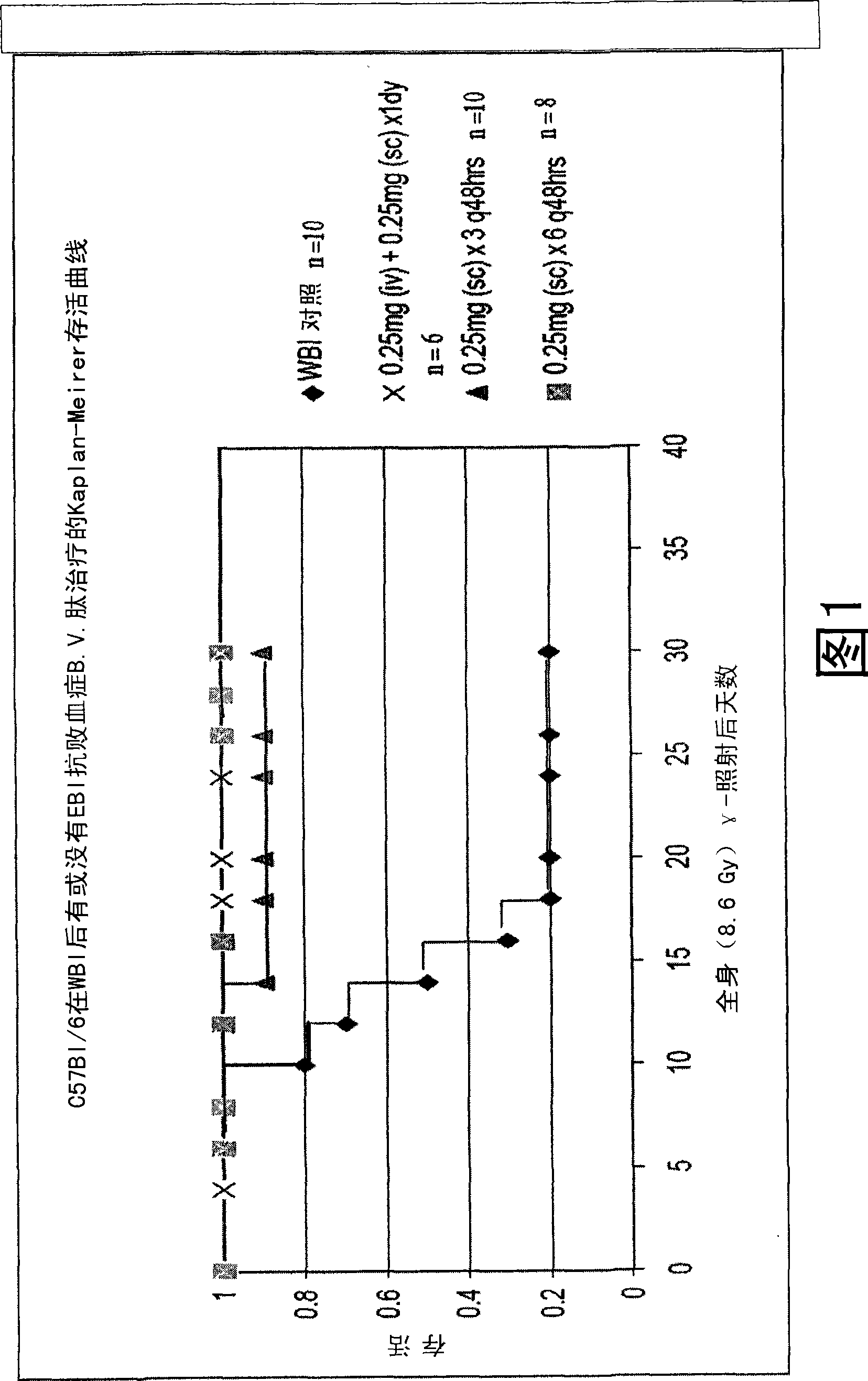Use of peptides for the control of radiation injury
A radiation injury and application technology, applied in the field of drug research and development of acute radiation injury, can solve problems such as cell cycle mitosis delay
- Summary
- Abstract
- Description
- Claims
- Application Information
AI Technical Summary
Method used
Image
Examples
Embodiment 1 and Embodiment 2
[0109] In the first experiment, 12-week-old female BALB / c mice were given a single intraperitoneal injection of PBS (n=9) or peptides (LGQV, VLPALP, LPGCPRGVNPVVS, MTRVLQGVLPALPQVVC; n=8, 10 mg / kg). Mice were systemically exposed to a single dose of 10 Gy 1.5 hours after treatment 137 Cs-γ-irradiation. In the second experiment, 12-week-old female BALB / c mice were first systemically exposed to a single dose of 10 Gy 137 Cs-γ-irradiation followed by a single intraperitoneal injection of PBS (n=9) or peptide (n=8 or 9, 10 mg / kg) 1.5 hours after irradiation. Mortality and clinical signs (eg, watery eyes indicating conjunctivitis, and weight loss) were observed at various time points during the experiment. It can be seen from Table 2 that all the tested peptides have a good effect on reducing conjunctivitis in the treated mice, but has no effect on the mortality rate, which prompted us to choose a peptide that is most suitable for fighting acute inflammation, so that in the later...
Embodiment 3
[0113] Six oligopeptides (i.e. A: LAGV, B: AQGV, C: LAG, D: AQG, E: MTR, and F: MTRV) were tested in double-blind animal experiments and compared with PBS (control), each peptide was tested Relative ability to promote recovery in the mouse kidney ischemia-reperfusion assay. In the experiment, mice were anesthetized and one kidney was removed. The other kidney was ligated for 25 minutes, and the serum urea level increased. Each of the different peptides (5 mg oligopeptide / kg body weight) was intravenously administered to 30 different mice before and after ligation, and then the mortality and BUN concentration of each peptide-treated mice were determined at 2 hours, 24 hours and 72 hours. The results are shown in Table 3 (excluding the results of peptide A (LAGV (SEQ ID NO: 4)) obtained in Example 3).
[0114] Under inhalational anesthesia, the left kidney was isolated with its arteries and veins and blocked with microvascular clamps for 25 minutes. Animals were placed on a h...
Embodiment 4
[0121] For the reasons mentioned previously, one oligopeptide (A) was retested for its ability to reduce BUN levels in mice. The results are shown in Table 4. It can be seen that the mice receiving the oligopeptide LAGV were much better than the control group (PBS) in terms of survival (significantly lower mortality compared to the PBS control group) and lower BUN concentration.
PUM
 Login to View More
Login to View More Abstract
Description
Claims
Application Information
 Login to View More
Login to View More - R&D
- Intellectual Property
- Life Sciences
- Materials
- Tech Scout
- Unparalleled Data Quality
- Higher Quality Content
- 60% Fewer Hallucinations
Browse by: Latest US Patents, China's latest patents, Technical Efficacy Thesaurus, Application Domain, Technology Topic, Popular Technical Reports.
© 2025 PatSnap. All rights reserved.Legal|Privacy policy|Modern Slavery Act Transparency Statement|Sitemap|About US| Contact US: help@patsnap.com



